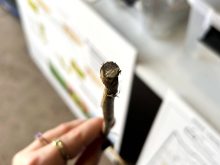Flea beetle damage was relatively low last year compared to the crushing pressure of previous seasons, but producers can’t afford complacency.
“There was less foliar insecticide used for flea beetles than the previous years, and maybe less flea beetles to some degree, but there were still a lot of flea beetles out there,” said Manitoba Agriculture entomologist John Gavloski.
Damage was limited last year because conditions allowed for good stand establishment.
Read Also

Glufosinate-resistant waterhemp found in U.S. Midwest
Kochia may also be on the road to Group 10 herbicide resistance, which would be a serious blow to Prairie farmers and canola growers, warns weed scientist.
“If you have conditions that hold the plants in the seedling stages for a prolonged period of time or if you have delayed germination, your seed treatments wear out and then you’ve got a vulnerable plant that’s still at a vulnerable stage.
“What happened last year was that we got some good conditions for the crop to get from seeding to the three to four leaf stage in three to four weeks. That’s the critical thing.”
Why it matters: It’s best to prepare for the worst when it comes to flea beetles.
The Canola Council of Canada is sending a similar message to farmers this spring through its “Stand Up to Flea Beetles” campaign.
“The biggest challenge with flea beetles is we just don’t know,” said CCC agronomist Keith Gabert. “We really can’t predict this particular insect pest, which is really humbling because it’s our No. 1 insect pest.”
Last year, everyone geared up for flea beetles based on problems in prior years. Spring 2022 had difficult spring conditions leading to late seeding and slow germination, leaving plants vulnerable.

Guard up
Gabert urges producers to maintain their defences. His “Stand Up to Flea Beetles” article, posted on the CCC’s website, outlines strategies to prepare for an infestation. Much of it centres on stand establishment.
He recommends a density of five to eight plants per square foot, which will spread out damage. Assuming a fixed number of flea beetles, more plants means fewer flea beetles per plant.
He also recommends shallow seeding in warm, moist soil. Seeding down into moisture may allow for germination but can result in poor or slow emergence so seed treatments dissipate. Gabert also suggested farmers avoid planting in cold conditions.
It’s a balance. Later seeding may stave off an infestation, and canola tends to retain yield potential longer than some other crops, but seeding too late may result in flowering during the heat of summer or increased risk of fall frost damage.
Flea beetles overwinter and wake up from hibernation hungry for a canola plant or related crop. Frequent scouting is required to measure damage and consider foliar control. Gabert said flea beetles usually come as a package deal with some other stress.
“It’s almost always that something else has gone wrong. We’ve got a little too much trash, some crusting or some type of plant establishment problem and fewer canola plants than we’d actually like.”
Old song, but good
Little presented information is new advice, Gabert acknowledged.
“I’ve been with the canola council now for more than 10 years and I asked the guy before me if there was anything I should know about. He said, ‘you can only tell growers to slow down and seed shallow for so long before you want to find another message, but that’s still the best message we have for managing this crop.’”
There are reasons for optimism this spring. Many meteorologists are forecasting a warm, dry season and although that might spark drought concerns, short-term moisture might be good.
“A grower under drought conditions is going to be really annoyed when he reads that, but we’ll do our best with the seed bed conditions that we have,” said Gabert.
Scouting is vital as temperatures rise. Flea beetles increase their activity once temperatures reach 15 C, and the hotter it gets, the more they feed. Recent research shows that feeding doubles for every five-degree temperature increase up to 25 C.
“That means that that jump between 20 and 25 is pretty significant. They’re already happy and eating a lot at 20 degrees, and they’ll still double their feeding rate at 25.”
Gabert noted farmers don’t typically scout daily unless they anticipate the need to spray. He urged them to rethink that if temperatures are rising.
“Daily scouting under hot conditions is something that’s advisable. It’s a matter of scouting frequently enough to stay ahead of the damage that’s there and still be proactive in any foliar insecticide management.
“Do all those little things when you’re seeding that you think will help that crop grow rapidly. In many cases, it’s simply a matter of not rushing or skipping some small steps.”
















